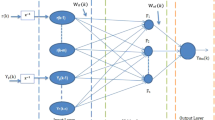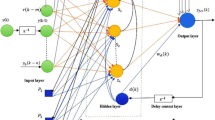Abstract
In this paper, a novel dynamic recurrent functional link neural network (DRFLNN) is proposed for the identification of unknown dynamics of the nonlinear systems. The proposed structure contains a self-feedback loop(s) as well as the adjustable weighted feed-through of the input signals to the output neuron(s). A learning algorithm is developed using the combination of Lyapunov stability and dynamic back-propagation method and is applied to derive the stable parameter adjustment equations. The performance evaluation of the proposed DRFLNN model is done by comparing it with the multi-layer perceptron (consisting of a single hidden layer), radial basis function network, Elman recurrent neural network (ERNN), nonlinear auto-regressive moving average, and the conventional functional link neural network. Three benchmark systems have been used on which all these models are applied. From the results, it is found that ERNN provided better prediction accuracy as compared to the remaining models and the second-best accuracy is obtained from the proposed model. Further, the ERNN model is more complex and offers more parameters to be tuned as compared to the DRFLNN model. Thus, the training of the ERNN model is quite difficult as compared to the DRFLNN.





















Similar content being viewed by others
References
Gish H (1990) A probabilistic approach to the understanding and training of neural network classifiers. In: 1990 International conference on acoustics, speech, and signal processing, 1990. ICASSP-90. IEEE, pp. 1361–1364
Zhang GP (2000) Neural networks for classification: a survey. IEEE Trans Syst Man Cybern Part C (Appl Rev) 30(4):451–462
Park YR, Murray TJ, Chen C (1996) Predicting sun spots using a layered perceptron neural network. IEEE Trans Neural Networks 7(2):501–505
Qi M, Zhang GP (2001) An investigation of model selection criteria for neural network time series forecasting. Eur J Oper Res 132(3):666–680
Narendra KS, Parthasarathy K (1990) Identification and control of dynamical systems using neural networks. IEEE Trans Neural Networks 1(1):4–27
Kumar R, Srivastava S, Gupta JRP (2017) Diagonal recurrent neural network based adaptive control of nonlinear dynamical systems using Lyapunov stability criterion, vol 67. ISA transactions, pp 407–427. https://doi.org/10.1016/j.isatra.2017.01.022
Patra J. C, Bornand C (2010) Nonlinear dynamic system identification using Legendre neural network. In: The 2010 international joint conference on neural networks (IJCNN), IEEE, pp 1–7
Chen S, Billings S (1992) Neural networks for nonlinear dynamic system modelling and identification. Int J Control 56(2):319–346
Giles CL, Maxwell T (1987) Learning, invariance, and generalization in high-order neural networks. Appl Opt 26(23):4972–4978
Venkatesh SS, Baldi P (1991) Programmed interactions in higher-order neural networks: maximal capacity. J Complex 7(3):316–337
Artyomov E, Yadid-Pecht O (2005) Modified high-order neural network for invariant pattern recognition. Pattern Recogn Lett 26(6):843–851
Hassim Y. M. M, Ghazali R (2013) Functional link neural network–artificial bee colony for time series temperature prediction. In: International conference on computational science and its applications. Springer, pp 427–437
Patra JC, Chin WC, Meher PK, Chakraborty G (2008) Legendre-flann-based nonlinear channel equalization in wireless communication system. In: IEEE international conference on systems, man and cybernetics, 2008. SMC 2008. IEEE, pp 1826–1831
Gupta T, Sachdeva SN (2019) Prediction of compressive and flexural strengths of jarosite mixed cement concrete pavements using artificial neural networks. Road Mater Pavement Des 1–22. https://doi.org/10.1080/14680629.2019.1702583
Sahoo DM, Chakraverty S (2018) Functional link neural network approach to solve structural system identification problems. Neural Comput Appl 30(11):3327–3338
Ma L, Khorasani K (2005) Constructive feedforward neural networks using hermite polynomial activation functions. IEEE Trans Neural Networks 16(4):821–833
Vyas BY, Das B, Maheshwari RP (2016) Improved fault classification in series compensated transmission line: comparative evaluation of Chebyshev neural network training algorithms. IEEE Trans Neural Netw Learn Syst 27(8):1631–1642
Zhao H, Zhang J (2009) Nonlinear dynamic system identification using pipelined functional link artificial recurrent neural network. Neurocomputing 72(13–15):3046–3054
Haykin S, Li L (1995) Nonlinear adaptive prediction of nonstationary signals. IEEE Trans Signal Process 43(2):526–535
Kumar R, Srivastava S, Gupta J (2017) Modeling and adaptive control of nonlinear dynamical systems using radial basis function network. Soft Comput 21(15):4447–4463
Gao X, Gao X, Ovaska S (1996) A modified Elman neural network model with application to dynamical systems identification. In: 1996 IEEE international conference on systems, man and cybernetics. Information intelligence and systems (Cat. No. 96CH35929), vol 2, IEEE, pp 1376–1381
Diaconescu E (2008) The use of narx neural networks to predict chaotic time series. Wseas Trans Comput Res 3(3):182–191
Haykin S (1994) Neural networks: a comprehensive foundation. Prentice Hall PTR, Upper Saddle River
Kumar R, Srivastava S, Gupta J, Mohindru A (2019) Comparative study of neural networks for dynamic nonlinear systems identification. Soft Comput 23(1):101–114
Abiyev RH, Kaynak O, Kayacan E (2013) A type-2 fuzzy wavelet neural network for system identification and control. J Frankl Inst 350(7):1658–1685
Mall S, Chakraverty S (2016) Hermite functional link neural network for solving the van der pol-duffing oscillator equation. Neural Comput 28(8):1574–1598
Raudys A, Mockus J (1999) Comparison of arma and multilayer perceptron based methods for economic time series forecasting. Informatica 10(2):231–244
Lee C-M, Ko C-N (2009) Time series prediction using RBF neural networks with a nonlinear time-varying evolution PSO algorithm. Neurocomputing 73(1–3):449–460
Wang J, Zhang W, Li Y, Wang J, Dang Z (2014) Forecasting wind speed using empirical mode decomposition and Elman neural network. Appl Soft Comput 23:452–459
Menezes JMP Jr, Barreto GA (2008) Long-term time series prediction with the Narx network: an empirical evaluation. Neurocomputing 71(16–18):3335–3343
Sugeno M, Yasukawa T (1993) A fuzzy-logic-based approach to qualitative modeling. IEEE Trans Fuzzy Syst 1(1):7
Author information
Authors and Affiliations
Corresponding author
Ethics declarations
Conflict of interest
There is no conflict of interest among the authors.
Funding
no agency has funded this research.
Ethical approval
This article does not contain any studies with human participants or animals performed by any of the authors.
Additional information
Publisher's Note
Springer Nature remains neutral with regard to jurisdictional claims in published maps and institutional affiliations.
Rights and permissions
About this article
Cite this article
Kumar, R., Srivastava, S. A novel dynamic recurrent functional link neural network-based identification of nonlinear systems using Lyapunov stability analysis. Neural Comput & Applic 33, 7875–7892 (2021). https://doi.org/10.1007/s00521-020-05526-x
Received:
Accepted:
Published:
Issue Date:
DOI: https://doi.org/10.1007/s00521-020-05526-x




